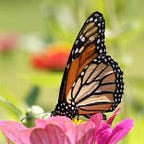FWS Behind the Lens: Chelsi Burns
Chelsi Burns grew up at the base of the Tuscarora mountains, in a rural community of Pennsylvania near the Appalachian Trail. She loves how mountain towns are often showing off the beauty of its valleys and streams, which are always vibrant with spring and fall colors. In her community, there were also local hobby artists one of which was her grandmother, who painted sycamore trees over limestone bridges and bustling creeks. This fostered Chelsi’s passion to create and capture those tranquil moments in nature and the wildlife that could be discovered there. While in middle and high school, she entered art competitions with a local Tuscarora Wildlife Education Project. She submitted her first ever painting of an American robin peering at its own reflection in a stream, which earned her an Honorable Mention. There, her love for drawing and painting wildlife, especially birds, took hold.
She began to use photography as a way to capture the wonders of nature while on family camping trips and travelling to new places. Chelsi found it more rewarding to paint from her own pictures. Using her own photos allowed her to instill the feelings and vibrant colors of those moments into her artwork. “She was always quick to fill a film roll. Thankfully the era of the digital camera was on the rise!”
“Photography is an incredible tool,” through it, she has captured the vibrancy, movement, persistence and resiliency of nature down to the finest details. It allows her to capture the feeling of an experience, and she loves being able to share these moments with others. In her ten years of working with the U.S. Fish and Wildlife Service, she has enjoyed taking pictures of nature and people, especially of conservation in action!
“Growing up, she visited Chincoteague NWR often and learned about the Delmarva Peninsula fox squirrel, a very large, endangered tree squirrel species that was managed by refuge staff and partners. It was a memorable moment when she caught a glimpse of these special creatures roaming the refuge.
One of her favorite wildlife moments happened there, years later, during a detail as the Visitor Services Manager. She took a walk down the Woodland Trail and saw something that made her stop and stare. Not only was there a pair of these Delmarva Peninsula fox squirrels in a nearby tree, but they were coming out of a natural tree cavity, not a human-made box. A few years before, the Delmarva Peninsula fox squirrel had been taken off the endangered species list thanks to the work of many in conservation.”
Chelsi earned her Bachelor’s in Environmental Science from Wilson College, in Pennsylvania and a Master’s in Park and Resource Management with a focus on Environmental Education from Slippery Rock University, Pennsylvania. She has worked at Minnesota Valley Wildlife Refuge, an urban refuge, as a Visitor Services Specialist on environmental education with K-6 grade students and led teacher trainings for field trips to the refuges, as well as, served as a Park Ranger at Chincoteague National Wildlife Refuge, one of the highest visited refuges in the nation.
Currently, she has the role of Urban and Visitor Services Coordinator for the National Wildlife Refuge System in the Northeast Regional Office. For the last five years, “Chelsi has supported staff in promoting meaningful visitor and wildlife-based experiences and facilitates conversations on establishing community-based conservation on and off Federal lands. This includes visioning and strategic planning with the region’s urban partnership cities and Visitor Services Planning with the regional Visitor Services team.” She goes on to say, “I am humbled and proud of my region’s collaborative achievements with partners in wildlife conservation and continually seek opportunities to leverage efforts for collective conservation impact with others.”
Chelsi continues to be passionate about nature-based photography while traveling within the United States and beyond. She always looks forward to camping, kayaking, and birding. During the pandemic, she has been learning how to use a DSLR camera with different lenses and is very excited to use it during her upcoming trip to New Zealand!
She has contributed several images to the National Digital Library, click on her collection view her images. Check out the story map for Urban Conservation in the Northeast, which features the programming that Chelsi supports. Through this blog, the USFWS Library aims to highlight different people in the field who have contributed spectacular photography, with an eye toward reflecting the full mission of the Service. Visit our FWS Media Library to find thousands of public domain images. Brought to you by the USFWS Library, #FWSBehindTheLens #WeAreUSFWS.
